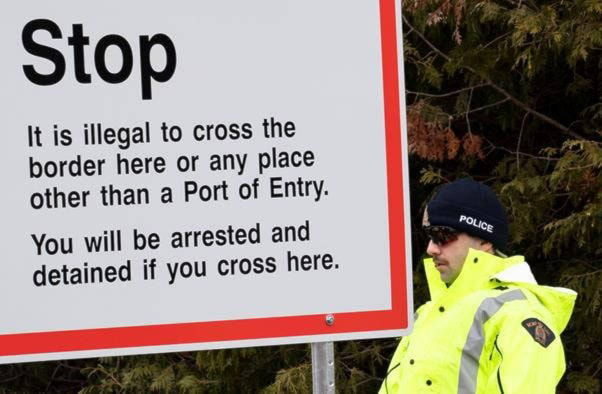The entire Canada-U.S. border should be designated as an official port of entry to help stop the flow of illegal migrants into Canada, says Conservative immigration critic Michelle Rempel.
Making such a change would give the RCMP and Canada Border Services Agency more tools to deal with an ongoing influx of asylum seekers crossing the border at unofficial entry points in Quebec and Ontario, Rempel said in an interview Thursday.
“I just really feel that unless we address this issue this is going to be unending and it’s unsustainable,” she said.
Immigration advocates have been calling on the government to suspend the Canada-U.S. Safe Third Country Agreement, which has been cited as a major factor in the spike of irregular border crossings.
The agreement prevents asylum seekers from asking for refugee protection when they present themselves at an official port of entry. They can only claim refugee status from inside Canada, which is why thousands have been crossing through unofficial entry points on foot.
If Ottawa doesn’t close that loophole, turning the entire border an official port of entry could offer an alternative solution, Rempel said.
READ MORE: Cabinet set to map out scenarios for dealing with illegal border-crossers
READ MORE: Advocates concerned about unaccompanied minors seeking asylum in Canada
But Public Safety Minister Ralph Goodale’s office was quick to shut down the idea, saying it would create even greater problems and dangers along the 9,000-kilometre border.
“It would incentivize people to cross at more remote locations and to evade detection by Canadian law enforcement so they can get to an inland immigration office and make a claim there,” said Goodale’s press secretary, Scott Bardsley.
“That would increase the risk to Canadians and asylum seekers alike.”
Concerns boiled over in Quebec this week over the mounting pressures caused by the tens of thousands of asylum seekers that have been pouring into that province over the last year.
Some officials are projecting a further 400 people a day could cross the border into Quebec through forest paths this summer to claim asylum in Canada — a situation Rempel warned will only exacerbate ongoing backlogs in the processing of refugee claims.
The Liberal government has said it is working to ease pressures caused by the surge in asylum claims, including dedicating $74 million this year to help reduce the processing backlogs at the Immigration and Refugee Board.
But the IRB is warning concentrated surges in refugee claims and appeals could negate any gains it makes in reducing backlogs. Last year, a 20 per cent improvement in processing was swallowed by a 40 per cent increase in cases.
“With wait times in excess of 12 months at all three divisions (of the IRB), the focus of the board over the next three years is to reduce those backlogs where resource levels permit or else to limit their growth,” says the board’s recently tabled department plan.
Changes have been made to streamline claims processing, including finalizing claims in the order in which they are received. But the board notes it can only improve the time it takes to adjudicate claims if it finalizes more cases than it receives, a factor that’s beyond its control.
In 2017-18, the board finalized 49,000 cases, up from 40,500 the previous year, but intake over the same period increased by twice that amount, from 50,700 in 2016-17 to 70,000 cases across all divisions, including refugee protection claims, appeals, detention reviews, inadmissibility hearings and immigration appeals.
Teresa Wright, The Canadian Press
